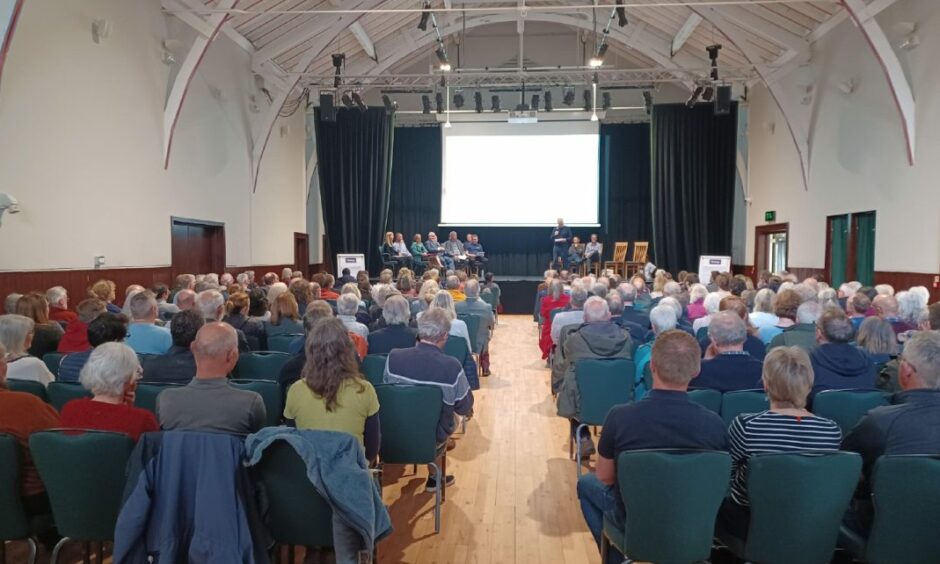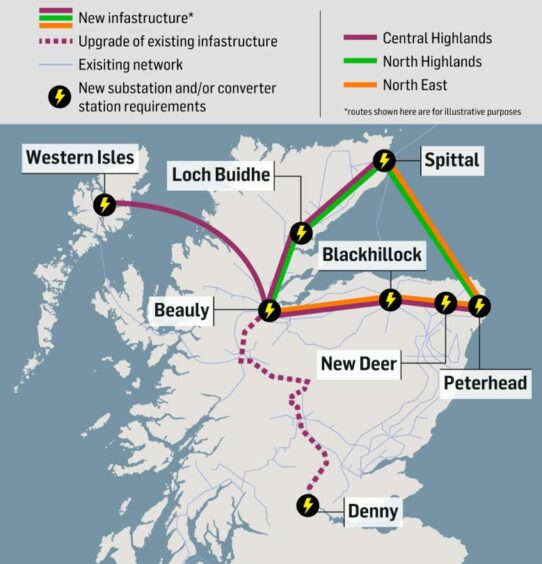Campaigners fighting a planned new power line in the Highlands say they are losing trust in SSEN and want the Scottish Government to intervene.
The power company is proposing a new 400KV overhead line from Spittal in Caithness to Beauly and on to Peterhead.
It has stressed it is considering alternative routes and mitigation measures in areas of particular local sensitivity.
But opponents say extensive aerial surveys are being carried out on SSEN’s ‘preferred route’ and no others without informing communities.
The Strathpeffer and Contin Better Cable Route group has now questioned the company’s ability to manage the project in an open and trustworthy way.
It wants the government to step in and oversee the project.
Proposed route ‘threatens damage to communities’
The group has launched a fighting fund to continue its campaign and a possible legal challenge against the plans.
Spokesman Dan Bailey says SSEN’s “unacceptable” proposed route threatens environmental, cultural and economic damage to communities.
“SSEN have been fully appraised of these concerns, and repeatedly assure us that they are actively considering a number of alternatives, including re-using the existing power line corridor.
“However, without informing residents, they have quietly moved development of the original plan to the next stage by commencing a series of very detailed aerial surveys for this route, and none other.
“If the company is genuinely open-minded about options, then why have they limited this major data gathering exercise to their flawed Plan A?”
The campaigners say in recent weeks they have spotted aeroplane traffic concentrated in areas along the Spittal-Beauly line and on other branches of SSEN’s proposed grid upgrades in Aberdeenshire and Angus.
Obtaining flight patterns, they say routes are consistent with LiDAR aerial surveys.
“They would like to reassure us that no decisions have yet been taken on potential overhead line routes or substation locations”, said Mr Bailey.
“However, extensive aerial surveys do beg the question – have decisions already been taken at the company behind closed doors?
“People feel that SSEN are saying one thing, but doing another.”
Calls for open and inclusive design process
SSEN says the upgrade to the transmission network is needed to connect renewables projects and support the drive towards net zero.
It says it will support tens of thousands of jobs and deliver billions of pounds of investment.
But Mr Bailey says the company has a commercial interest in a particular upgrade option.
He said an onshore overhead line by the most direct route possible is the easiest and cheapest way to connect with new onshore wind farms being proposed by SSE.
“In light of this interest, and the secrecy that has characterised the project to date, we do not consider SSEN to be competent to fairly oversee the project it has been tasked with delivering.
“We continue to press for the Scottish Government to step in and put ultimate oversight in the hands of a neutral third party who can bring all stakeholders together in an open and inclusive co-design process, to deliver the grid upgrades in a way that genuinely respects the interests of communities hosting the infrastructure.”
No decisions on potential routes have been taken
A SSEN Transmission spokesman said: “To help inform the ongoing development of this project, we have commenced LiDAR flights to undertake aerial surveys on potential overhead line routes.
“Whilst these initial surveys have prioritised those routes which, based on our initial assessment, have performed the best, we would like to reassure stakeholders that no decisions on potential overhead line routes have been taken.
“Should we establish viable alternatives that warrant more detailed investigations, they will also be surveyed accordingly.”
The spokesman said SSEN remains committed to working with all stakeholders who are willing to engage constructively.
This, he said, was demonstrated by ongoing consideration and assessment of an alternative route proposed by people in Strathpeffer.
The Scottish Government said: “It is critical that that investment in our grid infrastructure happens at the pace and scale required to enable the full utilisation of current renewable generation, and to realise the enormous potential of further deployment.
“It is also vital that such infrastructure is delivered at the most efficient cost to consumers and that local communities are fully engaged and derive lasting benefits.”
It said the planning and consenting system ensures large-scale grid infrastructure are subject to consultation with public and statutory bodies and communities.
“Potential impacts on communities, nature and other valued natural assets or cultural heritage are important considerations in the decision-making process.”
If you are interested in more exclusive and breaking Highland and Islands news from the P&J, join our dedicated Facebook page.



Conversation